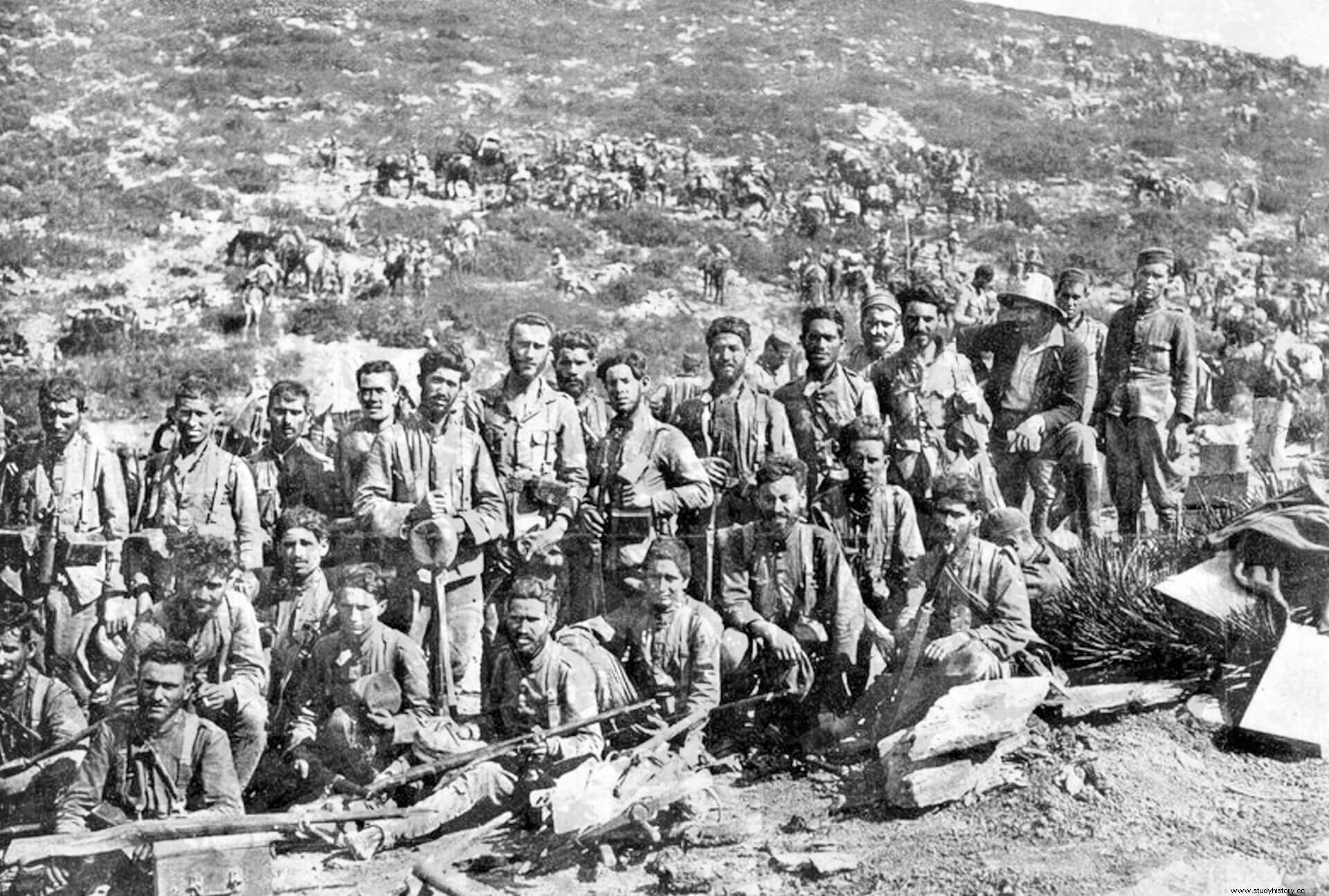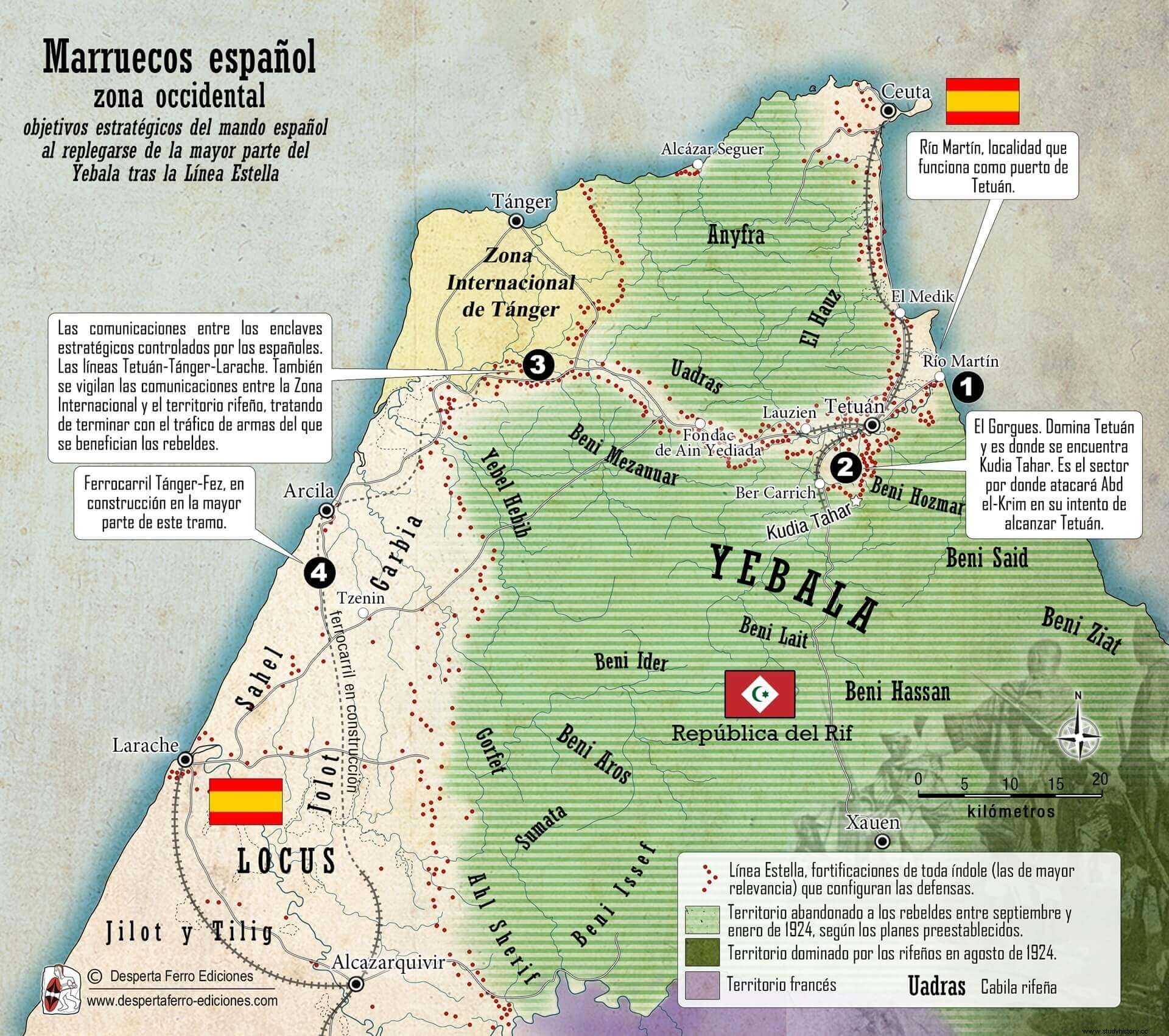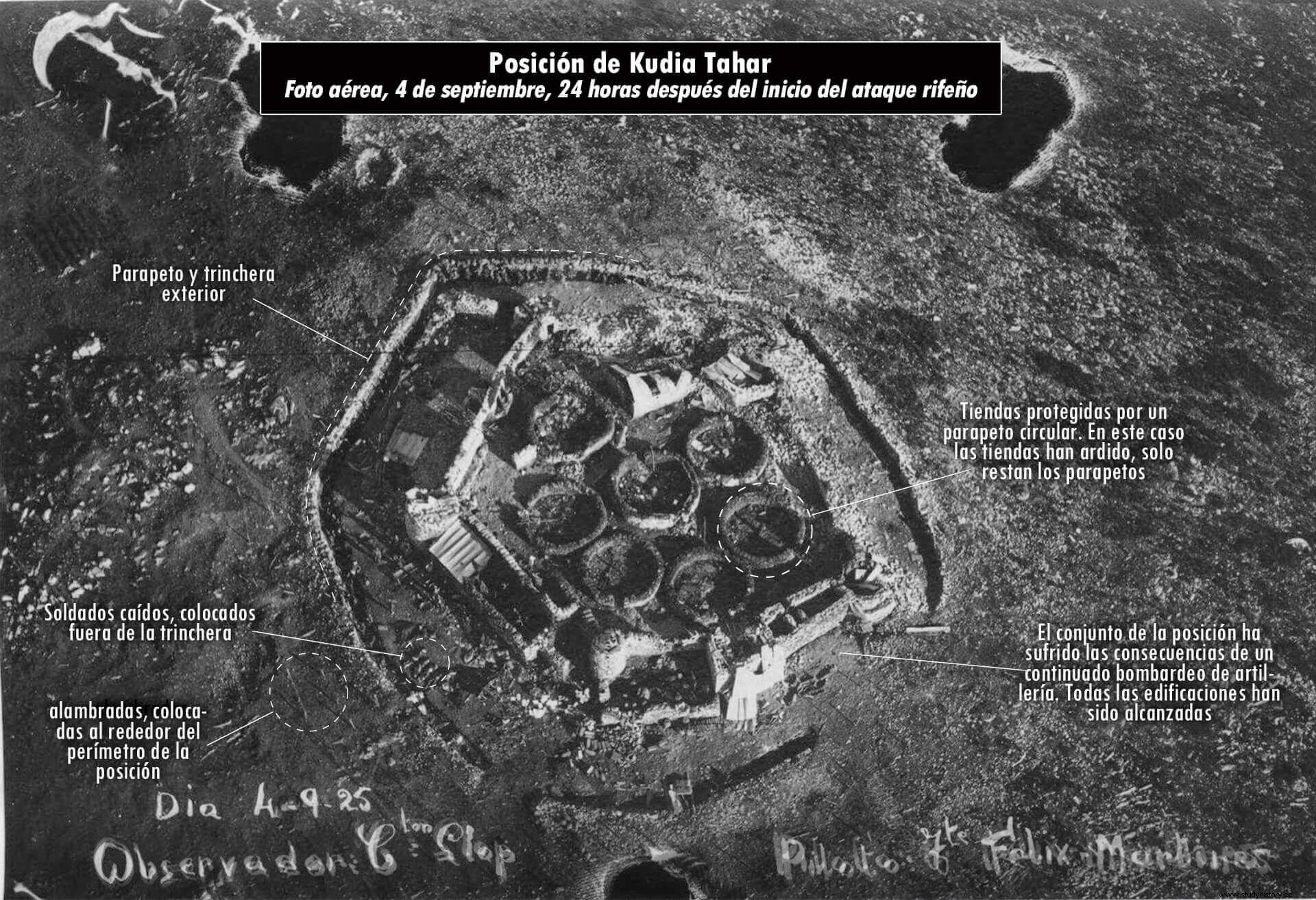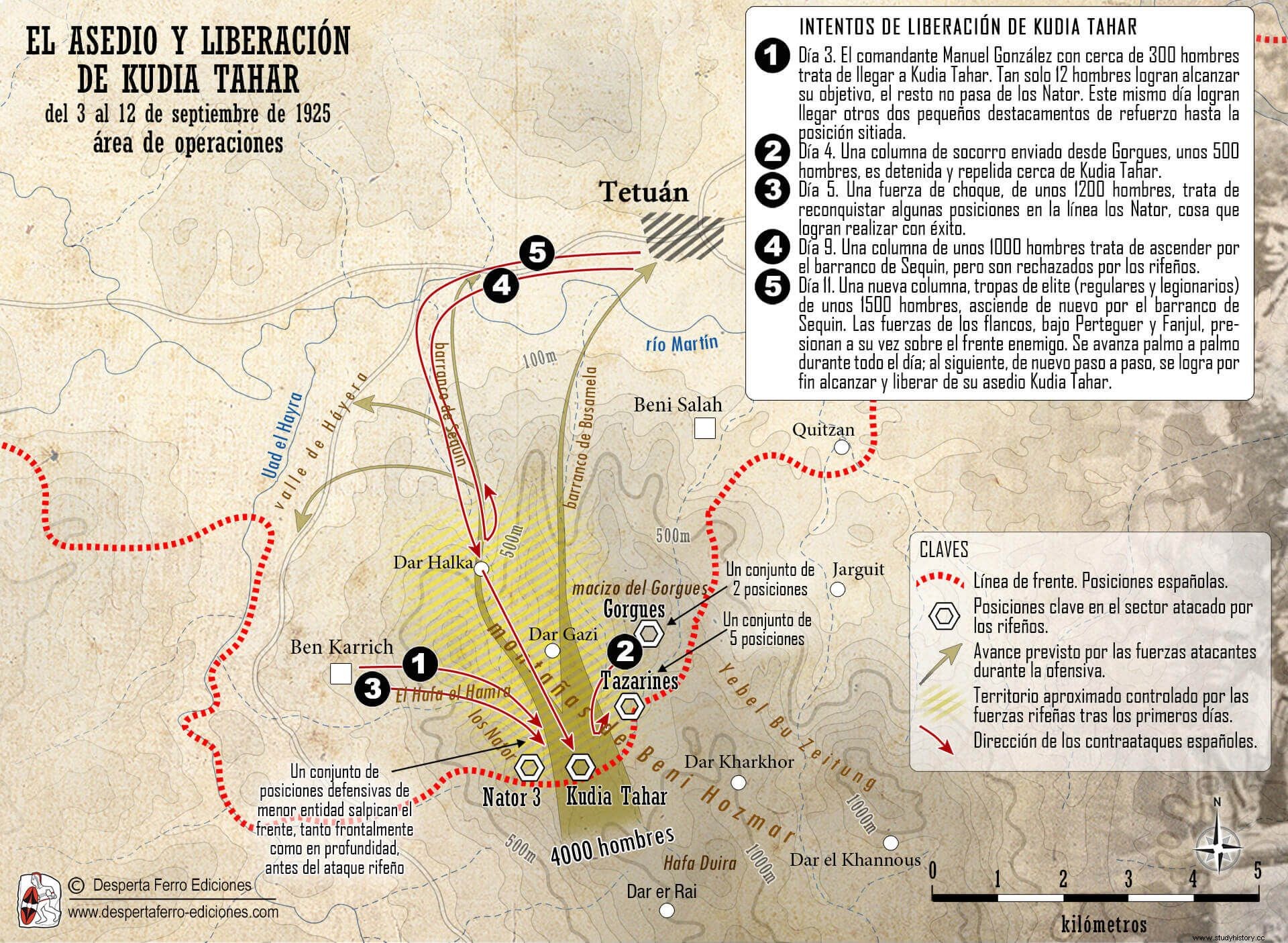
However, what at first seemed like a campaign simple military, it was enormously complicated by the orographic difficulty of the area granted to Spain –Rif mountain range – and the bellicosity of the tribes that inhabited it, in such a way that, from July 9, 1909, when there was an attack by the Rif people on a group of Spanish workers who worked in the vicinity of Melilla , a harsh military conflict began that would reach its climax with the Annual disaster in 1921, provoking an intense debate –sometimes not exempt from violence, as occurred with the famous Tragic Week in 1909– regarding the Spanish presence in Morocco .
This situation is what explains why, when Lieutenant General Miguel Primo de Rivera established his dictatorship, after the coup d'état given on September 13, 1923 in Barcelona, his first decision in relation to Morocco was to negotiate with the Rif caudillo Abd el-Krim , responsible for the defeat of Annual. The dictator's stance was logical from his position, since he was not an "Africanist" military man -although he had won the Laureate Cross of San Fernando during the Melilla campaign of 1893 and then had participated in some subsequent combats from 1909 –, but rather identified with the conservative elite –whose most prominent representative was Antonio Maura– who were committed to abandoning Morocco. However, Primo de Rivera's project collapsed because Abd el-Krim, who on September 18, 1921 had created the Rifeño Republican State, was not willing to accept any solution other than independence. Faced with this refusal, the dictator decided, at the beginning of 1924, to withdraw the Spanish Army in the western zone, towards Tetouan, which meant the abandonment of the mythical city of Xauen and the Yebala region and the establishment of the so-called Estella Line . With this last operation, Primo de Rivera pursued four objectives:the defense of Río Martín (port of Tetuán and its railway), conserving the Gorgues (fundamental point of the defense of Tetuán, capital of the Spanish Protectorate), maintaining communication between Tetuán and Larache and Tangier, and the control of the Tangier-Fez railway (an international commitment).
That is, it was an “abandonist” policy , but at the same time, aware that Spain could not neglect its international obligations in the area, since that would bring about the end of its status as a Mediterranean power and the more than possible replacement of the Spanish position in Morocco by France and Great Britain. It was, therefore, to make the Spanish influence felt in his area of the Protectorate "with other means", as a previous step to the definitive abandonment of the interior of it, as Sueiro affirms. However, this policy change caused not only numerous casualties (2,806 in September alone), but also strong tensions with the Africanist sector of the Army, as reflected on July 19 at the lunch that the officers and chiefs of the Legion and the Regulars offered to Primo de Rivera in the Ben Tieb legionary camp – on the outer line of the command of Melilla– and, above all, weakened the Spanish position, which in the spring of 1925 was very weak.
However, in this delicate situation for Spain, an event was going to take place that would radically change the situation in Morocco:Abd el-Krim's attack on the French zone on April 13, 1925. The decision of the Rif leader that, in the end, would lead to his ruin, can be difficult to explain if we only look at the Aussenpolitik (“foreign policy”), but it is logical if we focus on the Innenpolitik ("domestic policy"). Abd el-Krim depended on his prestige to maintain his position and the Republican Rif State, and that prestige could only be increased –after the victory of Annual and the Spanish withdrawal that for his Rif people was the prelude to the definitive defeat of Spain– through the attack on the French area of the Protectorate, which would allow him to seize its fertile lands.
As happened in the eastern part of the Spanish Protectorate, the offensive of 40,000 Rifs overwhelmed the French defenses in the Uarga river and modified the attitude of the resident general, Marshal of France Louis Hubert Gonzalve Lyautey, until then opposed to collaboration with Spain –his objective was always the occupation of the Spanish zone–, in what coincided with Primo de Rivera , whose abandonist policy did not go through the pacification of Morocco. Lyautey's change of position was accepted by the French Government, and joint negotiations began on June 17, 1925. in Madrid, whose objective was to end the power of Abd el-Krim. The Spanish delegation, led by Division General Alberto Castro Girona, opted from the outset for a landing in the Bay of Alhucemas – the source of the Rif rebellion – as the only way to put an end to the rebellion. This operation would be a huge personal triumph for the dictator in the face of public opinion and the Spanish Army itself, which would acclaim the architect of a company planned so many times but never carried out.

On the other hand, the occupation of the bay would prevent that, given its strategic value, Abd el-Krim could offer it as a bargaining chip to some country or foreign interest. Among all the dangers, according to Sueiro, Primo de Rivera was above all afraid of the communists, who could use Alhucemas as a base of operations to destabilize and threaten the security of the peninsula and even to "Bolshevikize" Spain, as he made known to the Brigadier General Francisco Gómez Jordana y Souza , true landing strategist, as head of the Military Directorate for Morocco and Colonies. However, the French commission chaired by Deputy Louis Malvy –a great connoisseur of Spain– initially opposed the Spanish plan although, after a series of interviews, including the one held in Tetouan on June 28 between Primo de Rivera and Marshal from France Phillippe Pétain –Inspector General of the Army, that is, the highest French military authority and generalissimo of the Army in case of conflict–, the French accepted the Spanish plan, thereby laying the foundations for the future joint collaboration envisaged in the agreement signed on 25 July 1925, both parties agreeing not to make a separate peace with Abd el-Krim.
According to the authors of the Military Historical Service, from that moment on, a mixed Spanish Army-Army commission began secretly preparing this amphibious operation. However, despite the agreement with France, Primo de Rivera did not give up on his abandoning projects, so he informed Abd-el-Krim of the action in progress, trying to convince him to accept a peaceful landing. Thus, if the Rif leader allowed the Spanish to occupy the bay, he would be granted an autonomous emirate over an extensive territory, which would also include part of the Melilla area, where the dictator undertook to carry out a withdrawal similar to the one carried out in 1924 in the western sector. With this action, Spain could get rid of two thirds of the Protectorate and keep only one, a coastal strip, as Sueiro affirms. Abd el-Krim, who did not accept any other negotiation than the one that would suppose the complete independence of the Rifeño Republican State, delayed the talks in order to entertain the Spaniards and buy the necessary time to reorganize and harvest the crops. However, when on August 28 the embarkation of the Spanish forces that were going to participate in the landing in Ceuta and Melilla began, the Rif leader understood that the operation was imminent and decided to act.
The attack on Kudia Tahar
The capital of the Spanish protectorate, Tetouan, was defended by a line of fortifications which, starting from the mouth of the river Martín, followed its course from east to west to the set of positions located in Bundara and then passing through Quitzan and Beni Salah, later extending through those installed in the vicinity of the Beni Hozmar massif, dominating it although partially, since the Rif people had in their possession the important observatory of Bu Zeitung and the Dar Rai pass, an obligatory passage for all the roads that went through the valley of the Martín River and to Tetouan from the heights of Beni Hassan.
Of this set of defensive positions, the most advanced were the Gorgues –recently fortified– and Kudia Tahar , both linked to each other by the posts of the back of Tazarines, and by those of Hafa el Ma and the Nator with Ben Karrich. This salient, and more specifically the position of Kudia Tahar, was the one chosen by Abd el-Krim to unleash an offensive action that would disrupt the landing plan in Al Hoceima. However, the objective pursued is not clear from the sources. According to Division General Manuel Goded Llopis, the Rif leader intended to conquer Kudia Tahar, breaking the line of the Tazarines and Nator forts, and then descending to the Martín River valley through the Mers, Busamelal and Sequim ravines – located between the buttresses of Hafa el Tuab and Hafa el Ma– and fall on Tetouan. For his part, Division General Federico de Souza y Regoyos affirmed that the objective was to break the front through the Assadem ravine and the Háyera valley to isolate Ben Carrich from Tetouan. In any case, it was an operation important enough to endanger the capital , especially when the shipment of troops from the western part of the protectorate to participate in the landing at Alhucemas had weakened its defenses.
To carry out the operation, Abd el-Krim made two decisions. The first is to order, before the attack, the infiltration of small groups through the ravines and towns located between Kudia Tahar and Tetouan, to entrench themselves in order to harass the advance of the liberating forces that would surely be sent from said locality. The second, to organize a harca made up of 4,000 men and 9 pieces of 75 and 105 mm artillery, under the command of Shaykh Jeriro, a former follower of Abd el-Krim's great rival, the Raisuni, who would be in charge of unleashing the action offensive by placing itself in a line slightly parallel to that formed by the Nator-Kudia Tahar-Tazarines sector and placing the artillery in the Hafa of Duira, which was 1,500 meters from Kudia Tahar and completely dominated it.

Kudia Tahar it was a quadrangular position, whose weak parapet was unable to resist artillery shells. Its garrison was made up of 130 men under the command of the infantry captain José Gómez Zaracíbar and was made up of a company from the 5th Infantry Regiment; an artillery detachment under the command of Lieutenant Ángel Mejón, which included Sergeant Miguel González, two corporals and 20 soldiers serving four 70mm Schneider mountain guns, and some telegraph operators handling a heliograph.
The attack began, at 5:40 a.m. on the morning of September 3, by means of an artillery bombardment of 75 and 105 mm disruptive grenades that was extraordinarily effective, since it dismantled the Spanish defenses and disabled Kudia Tahar's artillery. In fact, the fourth volley killed Mejón, González and nine gunners and disabled three of the four guns in the position. The fourth, manned by two soldiers, Mariano de la Iglesia and Laureano Iglesias, managed to fire a few more shots, until De la Iglesia, the shooter, was wounded. The losses of the Kudia Tahar garrison affected not only the artillery contingent, but also the infantry. Six soldiers and Lieutenant Carlos Ocasar Blanco died on the first day of fighting.
As soon as news of the attack became known, various relief forces were organized to liberate the besieged position. From Ben Karrich, on the 3rd, it was ordered to send a force under the command of Commander Manuel González Salom, made up of two infantry companies from the Hunters of Africa Battalion No. 6 and an artillery section under the command of Lieutenant Joaquín Fuentes Pila and integrated by Sergeant Antonio García and 20 artillerymen. These forces suffered, from the moment they left the barracks, the attack of the Rifian parties previously infiltrated and entrenched on the roads leading to Kudia Tahar, which caused heavy casualties. Thus, from the Fuentes Pila section only the lieutenant, the sergeant, the two corporals and no more than 8 soldiers managed to enter the besieged position. However, the Spanish troops were able to control the pass between Vázquez and the Nators, a very important line to maintain communications between Kudia Tahar and Ben Karrich. For his part, Engineer Lieutenant Ángel Sevillano Cousillas also received the order to organize a section to march to Kudia Tahar and make repairs on the parapet. This force entered the position around 3:00 p.m., but of the 40 men that formed it, only 26 arrived. A quartermaster detachment also entered, under the command of Lieutenant Francisco García Almenta.
On day 4 the Rif attack continued. The artillerymen, led by Fuentes Pila, were able to fire a few shots with the only useful cannon they had, but a grenade killed this lieutenant and destroyed the piece and from that moment on the defenders, who were reduced to 48 that same day, could only They responded with rifle fire and were subjected to powerful artillery fire, which destroyed the water drums of the position. For their part, the engineers led by Sevillano were unable to make the necessary repairs to the parapet, so Captain Gómez Zaracíbar ordered them to join the defending forces. The Spanish command, aware of the situation, organized a new relief expedition and from Gorgues a column departed under the command of infantry lieutenant colonel Buenaventura Hernández Francés that was about to be annihilated in the Assaden ravine by a Rif attack, which caused the death of said officer and seven indigenous soldiers. This failure led Primo de Rivera to order the general-in-chief of the Ceuta-Tetuán Zone, Souza Regoyos, to take command of the operations.
On the 5th, the situation in Kudia Tahar became even more complicated with the death of Captain Gómez Zaracíbar . Lieutenant Sevillano, being the oldest and despite being wounded, took command of a position that had already been completely demolished by artillery fire. For his part, infantry sergeant Mariano Ascoz Cabañero stayed with his 21 men in the blockhouses and then took refuge in the rocks, making it possible to defend the position. That same day, a tabor from the Group of Regular Indigenous Forces (GFRI) Ceuta No. 3 and a battalion from the Serrallo Infantry Regiment No. 69, sent as a relief force, were only able to take some lost positions in the line of the Nator, but at dawn from 5 to 6 a harca under the command of infantry lieutenant Bartolomé Muntané Cirici crossed the enemy lines and entered the position with supplies and water to save her.

As of day 6, the situation of the defenders of Kudia Tahar became unsustainable due to the shortage of food and the absolute lack of water and medicine . Sevillano, using the heliograph, requested that they send him water, ammunition and reinforcements. The first would arrive by air in the form of ice – the infantry lieutenant aviator Antonio Nombela Tomasich stood out for his courage – which would be thrown on the defenders, who many times were in serious danger when picking it up, a job in which the artillery soldier stood out John Fernandez. However, it was not enough, as Sevillano himself acknowledged in a heartbreaking paragraph:“Most of our Aragonese and Catalan soldiers vibrate with patriotic enthusiasm [...] the equitable distribution of the urine of the few cattle that we kept under cover is expected as a balm". The Rif people, knowing the desperate situation of the defenders and the psychological importance that the fall of the position could have, began to issue the following proclamations about them, according to what Sevillano himself declared:“Surrender! Don't shoot, we have entered Tetouan! If you surrender, we promise to respect your lives!” Proclamations that the defenders did not follow.
On the 9th, an operation organized around the columns of Lieutenant Colonel Eliseo Álvarez-Arenas and Colonels Prats and Joaquín Fanjul Goñi was stopped without being able to reach Dar Gazi, whose conquest was necessary to release the position. This new failure led Primo de Rivera to make two important decisions. The first was to send a telegram to Sevillano telling him that Kudia Tahar would soon be rescued. The second, to organize a powerful relief force formed by three columns:one made up of elite units of the Spanish Army that were already prepared to participate in the Alhucemas landing –two flags from the Tercio and a tabor from GFRI Melilla No. 2–, which would march under the orders of Lieutenant Colonel Amado Balmes infantry; and another two, under the command of Colonel Joaquín Perteguer and General Souza Regoyos, made up of units from the area. The whole group would be commanded by the general-chief of the Ceuta-Tetuán Zone. The objective was to liberate Kudia Tahar and the plan that was drawn up was as follows:after an intense artillery preparation, the Balmes shock forces would go through the Sequin ravine to Dar Gazi to expel the important enemy contingent established there, protecting this movement from the flanks the columns of Perteguer and Fanjul. Once this first objective was achieved, Kudia Tahar would be released.
The operation began at 8:00 a.m. on the 11th, but the difficulty of the terrain made it impossible to achieve the objectives set, so it was decided to fortify the conquered terrain and restart the operation on the same day Next. On the 12th, the Spanish troops set off as soon as dawn and, after a simple operation, took over the surroundings of Dar Gazi, in order to prepare the final attack, which was unleashed around 4:00 p.m. After a brutal fight, where the infantry commander Francisco García Escámez and the captain and lieutenant of the same arm, Miguel Rodrigo Martín and José Martínez Anglada, behaved with particular heroism, the soldiers of the Tercio managed to take the town using knives and hand grenades, causing 125 deaths to his enemies. The next day, after conquering the town of Assadan, and achieving the Nator line, Kudia Tahar was released . The siege was over.
Conclusion
The Kudia Tahar site was particularly important for three main reasons. The first, because it was a failure for the hitherto always victorious Abd el-Krim, which contributed to discredit him in the Yebala area, but above all prevented him from stopping the Alhucemas landing, as was his purpose. The second, because it meant the rehabilitation of the Spanish soldier as an effective combatant. As Woolman stated, this combat demonstrated that "the Spanish soldier, properly positioned and supplied, was as good as any other, in any kind of fight." And the third, because it was a victory for an army, the Spanish, which had not stopped suffering major setbacks since 1921. In fact, the victory in Kudia Tahar was the prelude to the success in Alhucemas . And this is how Primo de Rivera understood it, who was especially generous in awarding decorations, to the extent that Juan Pando has called it the "combat of the laureates" because, according to this historian, ten were awarded, although there were nine, already that that of infantry lieutenant Ricardo Quiroga García was granted for the battle of Gorgues on September 18. The nine laureates were:García Zaracíbar, Sevillano Cousillas, Fuentes Pila, Muntané Cirici, Nombela Tomarich, Martínez Anglada, Ascoz Cabañero, Rodrigo Martínez and García Escámez. That generosity reached all the survivors of the position, who personally received a cigar and 125 pesetas from Primo de Rivera.
Bibliography
- Muñoz Bolaños, R.; De Mesa Gutiérrez, J. L.; Lázaro Ávila, C.; Núñez Calvo, J. N. (2001):The Campaigns of Morocco. 1909-1927 . Madrid:Battlement.
- Pando Despierto, J. (1999):Annual's secret history. Madrid:Today's Topics.
- Sueiro Seoane, S. (1994):“The myth of the strategist. Primo de Rivera and the resolution of the Moroccan problem”, Cuadernos de Historia Contemporánea, 16, 113-129.
- VVAA. (1988):History of the Campaigns of Morocco, Volume 3. Madrid:Military Historical Service.
- Woolman, D. S. (1988):Abd el Krim and the Rif War. Barcelona:Oikos Tau.
